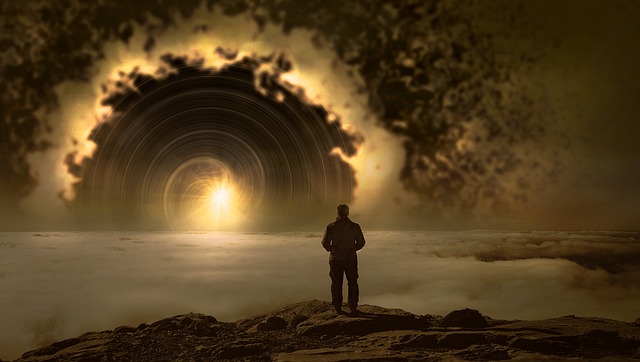In various cultures and religions, the moon has been symbolically associated with different deities or divine figures. These associations often vary depending on the specific cultural and religious beliefs.
Table of Contents
The Spiritual Significance of the Moon in Religious Beliefs
The moon has always held a special place in human culture and spirituality. Throughout history, people have looked up at the night sky and marveled at the beauty and mystery of the moon. In many religious beliefs, the moon is seen as a symbol of divinity and spirituality. It is often associated with various gods and goddesses, each representing different aspects of life and the universe.
In ancient Greek mythology, the moon was associated with the goddess Artemis. She was the twin sister of Apollo, the sun god, and was known as the goddess of the hunt and the protector of women and children. Artemis was often depicted with a crescent moon on her forehead, symbolizing her connection to the lunar cycle. She was seen as a powerful and independent deity, embodying the feminine energy of the moon.
In Hinduism, the moon is associated with the god Chandra. Chandra is considered one of the Navagrahas, or nine celestial deities, and is believed to govern the mind and emotions. In Hindu mythology, Chandra is depicted as a fair and handsome deity, riding a chariot pulled by ten white horses. He is often shown holding a lotus flower, symbolizing purity and enlightenment. Chandra is seen as a benevolent god, bringing peace and tranquility to those who worship him.
In Norse mythology, the moon is associated with the god Mani. Mani is the brother of the sun goddess Sol and is believed to ride across the sky in a chariot, pulling the moon behind him. He is often depicted as a young man with a pale complexion, reflecting the moon’s silvery glow. Mani is seen as a gentle and mysterious deity, guiding the moon through the night and illuminating the darkness.
In many Native American cultures, the moon is seen as a powerful and sacred symbol. The Lakota Sioux, for example, believe that the moon is a manifestation of the Great Spirit, Wakan Tanka. They see the moon as a source of guidance and wisdom, and they often hold ceremonies and rituals to honor its energy. The moon is also associated with the feminine energy and is seen as a symbol of fertility and abundance.
In modern Wiccan and pagan traditions, the moon plays a central role in spiritual practices. Wiccans often celebrate the phases of the moon, using its energy for rituals and spellwork. The full moon is seen as a time of heightened spiritual energy, while the new moon is a time for setting intentions and starting new projects. The moon is seen as a symbol of the divine feminine and is associated with goddesses such as Diana, Selene, and Hecate.
Overall, the moon holds a deep spiritual significance in many religious beliefs. It is seen as a symbol of divinity, femininity, and the cyclical nature of life. Whether it is associated with gods and goddesses or revered as a manifestation of the divine itself, the moon continues to inspire awe and wonder in people around the world. So, the next time you gaze up at the night sky and see the moon shining brightly, take a moment to appreciate its spiritual significance and the connection it holds to the divine.
Exploring the Symbolic Connection Between God and the Moon

The moon has always held a special place in human culture and mythology. Its gentle glow and mysterious presence in the night sky have captivated people for centuries. In many ancient civilizations, the moon was associated with various gods and goddesses, each representing different aspects of life and the natural world. In this article, we will explore the symbolic connection between God and the moon.
One of the most well-known gods associated with the moon is the Greek god Apollo. Apollo was the god of light, music, and prophecy, and he was often depicted as a young man with a radiant crown and a bow and arrow. The moon was believed to be his chariot, carrying him across the sky each night. Apollo’s association with the moon symbolized his power over light and his ability to bring enlightenment and knowledge to the world.
In Norse mythology, the moon was associated with the god Mani. Mani was the brother of the sun goddess Sol and was responsible for guiding the moon across the night sky. He was often depicted as a young man with a gentle and serene demeanor. Mani’s association with the moon symbolized his role as a guardian of the night and a bringer of peace and tranquility.
In Hindu mythology, the moon is associated with the god Chandra. Chandra is often depicted as a young and handsome man with a crescent moon adorning his forehead. He is considered the ruler of the night and is associated with emotions, intuition, and the feminine energy. Chandra’s association with the moon symbolizes his ability to bring balance and harmony to the world.
In ancient Egyptian mythology, the moon was associated with the god Thoth. Thoth was the god of wisdom, writing, and magic. He was often depicted as a man with the head of an ibis or a baboon. Thoth’s association with the moon symbolized his role as a keeper of knowledge and a guide to the afterlife.
In Native American cultures, the moon is often associated with the Great Spirit or the Creator. The moon is seen as a symbol of the cyclical nature of life and the connection between the physical and spiritual worlds. The Great Spirit is believed to watch over and guide all living beings, just as the moon watches over the earth each night.
The symbolic connection between God and the moon is not limited to these specific gods and goddesses. In many cultures, the moon is seen as a divine and sacred entity, representing the divine feminine, intuition, and the cycles of life. It is a symbol of light in the darkness, a source of guidance and inspiration.
In conclusion, the moon has long been associated with various gods and goddesses in different cultures around the world. These associations symbolize different aspects of life, such as light, wisdom, peace, and spirituality. The moon’s gentle glow and mysterious presence continue to captivate us, reminding us of the divine forces that shape our world.
The Moon as a Divine Representation in Mythology and Folklore
The moon has always held a special place in human culture. Its gentle glow and mysterious presence have captivated people for centuries. In mythology and folklore, the moon is often associated with various gods and goddesses, each representing different aspects of life and the universe. Let’s explore some of these divine representations and what they symbolize.
In ancient Greek mythology, the moon was personified by the goddess Selene. She was believed to ride her silver chariot across the night sky, illuminating the world below. Selene was often associated with femininity, beauty, and fertility. Her gentle light was seen as a symbol of hope and renewal, bringing comfort to those who gazed upon it.
In Norse mythology, the moon was associated with the god Mani. He was said to be the brother of the sun goddess Sol and together they traversed the sky, each taking turns to bring light to the world. Mani was often depicted as a calm and serene figure, representing tranquility and introspection. His presence in the night sky was seen as a reminder to take a moment to reflect and find peace within oneself.
In Hindu mythology, the moon is personified by the god Chandra. He is often depicted as a young and handsome deity, adorned with a crescent moon on his forehead. Chandra is associated with emotions, intuition, and the mind. His gentle light is believed to have a calming effect on the human psyche, helping to soothe troubled thoughts and bring clarity to the mind.
In Chinese mythology, the moon is associated with the goddess Chang’e. She is often depicted as a beautiful woman who resides on the moon with her companion, the Jade Rabbit. Chang’e is a symbol of love, beauty, and immortality. Legend has it that she was granted eternal life and banished to the moon as punishment for stealing the elixir of immortality. Her presence in the night sky serves as a reminder of the power of love and the consequences of our actions.
In Native American folklore, the moon is often associated with various gods and goddesses depending on the tribe. For example, the Lakota people believe that the moon is the home of Hanwi, the goddess of the moon. She is seen as a protector and a guide, watching over the earth and its inhabitants. Hanwi is also associated with dreams and visions, believed to communicate messages from the spiritual realm to those who are open to receiving them.
Across different cultures and civilizations, the moon has been revered as a divine entity, representing different aspects of life and the universe. Whether it is the gentle and nurturing presence of Selene, the introspective and calming energy of Mani, or the emotional and intuitive nature of Chandra, the moon holds a special place in our collective consciousness.
Next time you gaze up at the night sky and see the moon shining brightly, take a moment to appreciate the rich mythology and folklore that surrounds this celestial body. Let its divine representations remind you of the beauty and wonder that exists in the world, and the importance of finding balance and harmony within ourselves.
Unveiling the Symbolic Meanings of the Moon in Different Religions
The moon has always held a special place in human culture and spirituality. Its gentle glow and mysterious presence have captivated people for centuries, leading to various interpretations and symbolic meanings across different religions. In this article, we will explore the symbolic significance of the moon in some of the world’s major religions.
In Christianity, the moon is often associated with femininity and the Virgin Mary. Just as the moon reflects the light of the sun, Mary is seen as a reflection of God’s divine grace. The moon’s phases, waxing and waning, are also seen as a metaphor for the cycle of life and death, mirroring the resurrection of Jesus Christ.
Moving on to Hinduism, the moon is personified as the deity Chandra, who is considered the ruler of the mind and emotions. Chandra is often depicted as a young and handsome man with a crescent moon adorning his forehead. In Hindu mythology, the moon is believed to have a calming influence on the mind and is associated with love, beauty, and creativity.
In Islam, the moon holds great significance as it marks the beginning and end of the lunar month, which determines the timing of important religious observances. The crescent moon is a symbol of the Islamic faith and is often used to represent the Muslim community. Moreover, the moon is seen as a reminder of Allah’s power and creation, serving as a source of inspiration and contemplation for believers.
In Buddhism, the moon is seen as a symbol of enlightenment and spiritual awakening. Just as the moon illuminates the darkness of the night, the Buddha’s teachings are believed to bring light and wisdom to the world. The full moon is particularly revered in Buddhism, as it represents the state of complete enlightenment and the attainment of nirvana.
In ancient Egyptian religion, the moon was associated with the goddess Isis, who was often depicted with a crescent moon headdress. Isis was considered the mother goddess and the protector of the dead. The moon’s cycles were believed to mirror the journey of the soul through the afterlife, with the full moon representing rebirth and renewal.
In Native American cultures, the moon is revered as a powerful spiritual force. Different tribes have their own interpretations and names for the moon, such as the Lakota Sioux’s “Hanhepi Wi” or “Night Sun.” The moon is seen as a guide and protector, providing light in the darkness and influencing the natural world. Many Native American rituals and ceremonies are conducted in accordance with the lunar calendar.
As we can see, the moon holds diverse symbolic meanings in different religions. From femininity and resurrection in Christianity to enlightenment and rebirth in Buddhism, the moon serves as a powerful metaphor for various aspects of spirituality. Its gentle glow continues to inspire and guide believers across the globe, reminding us of the interconnectedness of all religious traditions and the universal human quest for meaning and transcendence.
Conclusion
In various mythologies and religions, different gods and goddesses are associated with the moon. Some examples include:
1. In Greek mythology, the moon is associated with the goddess Artemis, who is the twin sister of Apollo and the daughter of Zeus. She is often depicted as the goddess of the hunt, wilderness, and the moon.
2. In Norse mythology, the moon is associated with the god Mani. He is believed to be the personification of the moon and is often depicted as a male figure who rides across the night sky.
3. In Hindu mythology, the moon is associated with the god Chandra. He is considered as the lunar deity and is often depicted as a young and handsome man who rides a chariot pulled by ten white horses.
4. In ancient Egyptian mythology, the moon is associated with the god Thoth. He is considered as the god of wisdom, writing, and the moon. Thoth is often depicted as a man with the head of an ibis or a baboon.
These are just a few examples of the various gods and goddesses that symbolize the moon in different mythologies and religions. The symbolism and significance of the moon vary across cultures, but it often represents femininity, cycles, and the passage of time.
For licensing reasons, we must provide the following notice: This content was created in part with the help of an AI.


